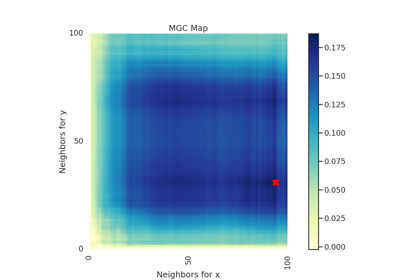Hsic¶
-
class
hyppo.independence.Hsic(compute_kernel='gaussian', bias=False, **kwargs)¶ Hilbert Schmidt Independence Criterion (Hsic) test statistic and p-value.
Hsic is a kernel based independence test and is a way to measure multivariate nonlinear associations given a specified kernel 1. The default choice is the Gaussian kernel, which uses the median distance as the bandwidth, which is a characteristic kernel that guarantees that Hsic is a consistent test 1 2.
- Parameters
compute_kernel (
str,callable, orNone, default:"gaussian") -- A function that computes the kernel similarity among the samples within each data matrix. Valid strings forcompute_kernelare, as defined insklearn.metrics.pairwise.pairwise_kernels,[
"additive_chi2","chi2","linear","poly","polynomial","rbf","laplacian","sigmoid","cosine"]Note
"rbf"and"gaussian"are the same metric. Set toNoneor"precomputed"ifxandyare already similarity matrices. To call a custom function, either create the similarity matrix before-hand or create a function of the formmetric(x, **kwargs)wherexis the data matrix for which pairwise kernel similarity matrices are calculated and kwargs are extra arguements to send to your custom function.bias (
bool, default:False) -- Whether or not to use the biased or unbiased test statistics.**kwargs -- Arbitrary keyword arguments for
compute_kernel.
Notes
The statistic can be derived as follows 1:
Hsic is closely related distance correlation (Dcorr), implemented in
hyppo.independence.Dcorr, and exchanges distance matrices \(D^x\) and \(D^y\) for kernel similarity matrices \(K^x\) and \(K^y\). That is, let \(x\) and \(y\) be \((n, p)\) samples of random variables \(X\) and \(Y\). Let \(K^x\) be the \(n \times n\) kernel similarity matrix of \(x\) and \(K^y\) be the \(n \times n\) be the kernel similarity matrix of \(y\). The Hsic statistic is,\[\mathrm{Hsic}^b_n (x, y) = \frac{1}{n^2} \mathrm{tr} (D^x H D^y H)\]Hsic and Dcov are exactly equivalent in the sense that every valid kernel has a corresponding valid semimetric to ensure their equivalence, and vice versa 3 4. In other words, every Dcorr test is also an Hsic and vice versa. Nonetheless, implementations of Dcorr and Hsic use different metrics by default: Dcorr uses a Euclidean distance while Hsic uses a Gaussian median kernel. We consider the normalized version (see
hyppo.independence) for the transformation.The p-value returned is calculated using a permutation test using
hyppo.tools.perm_test. The fast version of the test useshyppo.tools.chi2_approx.References
- 1(1,2,3)
Arthur Gretton, Kenji Fukumizu, Choon Teo, Le Song, Bernhard Schölkopf, and Alex Smola. A Kernel Statistical Test of Independence. Advances in Neural Information Processing Systems, 2007.
- 2
Arthur Gretton and László Györfi. Consistent Nonparametric Tests of Independence. Journal of Machine Learning Research, 11(46):1391–1423, 2010.
- 3
Cencheng Shen and Joshua T. Vogelstein. The exact equivalence of distance and kernel methods in hypothesis testing. AStA Advances in Statistical Analysis, September 2020. doi:10.1007/s10182-020-00378-1.
- 4
Dino Sejdinovic, Bharath Sriperumbudur, Arthur Gretton, and Kenji Fukumizu. Equivalence of distance-based and RKHS-based statistics in hypothesis testing. The Annals of Statistics, 41(5):2263–2291, October 2013. doi:10.1214/13-AOS1140.
Methods Summary
|
Helper function that calculates the Hsic test statistic. |
|
Calculates the Hsic test statistic and p-value. |
-
Hsic.statistic(x, y)¶ Helper function that calculates the Hsic test statistic.
- Parameters
x,y (
ndarrayoffloat) -- Input data matrices.xandymust have the same number of samples. That is, the shapes must be(n, p)and(n, q)where n is the number of samples and p and q are the number of dimensions. Alternatively,xandycan be kernel similarity matrices, where the shapes must both be(n, n).- Returns
stat (
float) -- The computed Hsic statistic.
-
Hsic.test(x, y, reps=1000, workers=1, auto=True, random_state=None)¶ Calculates the Hsic test statistic and p-value.
- Parameters
x,y (
ndarrayoffloat) -- Input data matrices.xandymust have the same number of samples. That is, the shapes must be(n, p)and(n, q)where n is the number of samples and p and q are the number of dimensions. Alternatively,xandycan be kernel similarity matrices, where the shapes must both be(n, n).reps (
int, default:1000) -- The number of replications used to estimate the null distribution when using the permutation test used to calculate the p-value.workers (
int, default:1) -- The number of cores to parallelize the p-value computation over. Supply-1to use all cores available to the Process.auto (
bool, default:True) -- Automatically uses fast approximation when n and size of array is greater than 20. IfTrue, and sample size is greater than 20, thenhyppo.tools.chi2_approxwill be run. Parametersrepsandworkersare irrelevant in this case. Otherwise,hyppo.tools.perm_testwill be run.
- Returns
Examples
>>> import numpy as np >>> from hyppo.independence import Hsic >>> x = np.arange(100) >>> y = x >>> stat, pvalue = Hsic().test(x, y) >>> '%.1f, %.2f' % (stat, pvalue) '1.0, 0.00'

